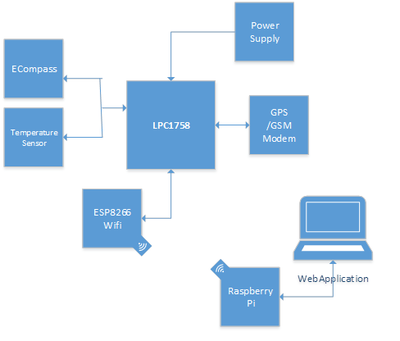S16: Warriors
Contents
Grading Criteria
- How well is Software & Hardware Design described?
- How well can this report be used to reproduce this project?
- Code Quality
- Overall Report Quality:
- Software Block Diagrams
- Hardware Block Diagrams
- Schematic Quality
- Quality of technical challenges and solutions adopted.
Project Title
Internet of Things based GPS Tracking System
Abstract
Internet of Things based GPS & GSM tracking system with a user-friendly web page interface that enables transportation industry to keep track of their vehicle with the timestamp. This project also involves the data collection from different sensors like the temperature sensor and the light sensor that can help to provide an alert if required conditions are not matched for carrying some sensitive goods like medicine.
Introduction
The project shows the implementation of Internet of Things based GPS tracking system with an add-on feature that is the collection of data from sensors attached to the microcontroller. The data is being stored on APACHE web server running on raspberry pi to eliminate the problem of memory storage space on the hardware. The output is being shown on the web page with a user-friendly interface that will show the latitude & longitude of the current location, temperature, and luminosity at every timestamp. The aim of this project is to make a tracking system with a user-friendly interface that can be used to track the route taken by the vehicle and ambience like temperature and light conditions so the owner need not worry about the illicit use of their vehicle.
Team Members & Responsibilities
- Ankit Gandhi
- Rasberry Pi environment setup, Hardware support
- Bharat Khanna
- Interface ESP8266 with ARM microcontroller, Hardware support
- Sujeeth Emmadi
- Veena Manasa Kanakamalla
Schedule
This section of the report provides the team schedule for the Assembly line project, indicating the milestones to be achieved during the course of the project.
| SI No. | Start Date | End Date | Task | Status | Actual Completion Date |
|---|---|---|---|---|---|
| 1 | 03/21/2016 | 03/27/2016 |
|
Completed | |
| 2 | 03/28/2016 | 04/03/2016 |
|
Completed | |
| 3 | 04/04/2016 | 04/10/2016 |
|
Completed | |
| 4 | 04/11/2016 | 04/17/2016 |
|
Completed | |
| 5 | 04/18/2016 | 04/24/2016 |
|
Completed | |
| 6 | 04/25/2016 | 05/01/2016 |
|
Completed | |
| 7 | 05/02/2016 | 05/08/2016 |
|
Completed | |
| 8 | 05/09/2016 | 05/15/2016 |
|
In Progress | |
| 8 | 05/16/2016 | 05/22/2016 |
|
In Progress |
Parts List & Cost
| Item# | Part Description | Vendor | Qty | Cost |
|---|---|---|---|---|
| 1 | Raspberry Pi | Adafruit | 1 | $39.95 |
| 2 | ESP8266-Wifi Module | Adafruit | 1 | $9.95 |
| 3 | SIM808 GPS/GSM Module | Adafruit | 1 | $49.95 |
| 4 | Passive GPS Antenna uFL | Adafruit | 1 | $3.95 |
| 5 | USB to TTL Serial Cable | Adafruit | 1 | $9.95 |
Design & Implementation
The design section can go over your hardware and software design. Organize this section using sub-sections that go over your design and implementation. Block Diagram
Hardware design for GPS, LSM303 ans ESP8266 interface. peripheral interface board design
Raspberry Pi
- Raspberry Pi is powered with Broadcom BCM2837 1.2GHz 64-bit quad-core ARMv8 processor.
- Integrated 802.11n wireless LAN
- Raspberry Pi is used as Web Server
SIM808 GPS/GSM Module
- Raspberry Pi is powered with Broadcom BCM2837 1.2GHz 64-bit quad-core ARMv8 processor.
- Integrated 802.11n wireless LAN
- Raspberry Pi is used as Web Server
ESP8266 Wifi Module
- Raspberry Pi is powered with Broadcom BCM2837 1.2GHz 64-bit quad-core ARMv8 processor.
- Integrated 802.11n wireless LAN
- Raspberry Pi is used as Web Server
Hardware Interface
In this section, you can describe how your hardware communicates, such as which BUSes used. You can discuss your driver implementation here, such that the Software Design section is isolated to talk about high level workings rather than inner working of your project.
Software Design
Show your software design. For example, if you are designing an MP3 Player, show the tasks that you are using, and what they are doing at a high level. Do not show the details of the code. For example, do not show exact code, but you may show psuedocode and fragments of code. Keep in mind that you are showing DESIGN of your software, not the inner workings of it.
Implementation
This section includes implementation, but again, not the details, just the high level. For example, you can list the steps it takes to communicate over a sensor, or the steps needed to write a page of memory onto SPI Flash. You can include sub-sections for each of your component implementation.
Testing & Technical Challenges
Describe the challenges of your project.
- First and very important aspect for any project is requirement gathering.
Make a smooth transition to testing section and described what it took to test your project.
Include sub-sections that list out a problem and solution, such as:
My Issue #1 LPC17xx UART Rx FIFO
- LPC17xx UART not able to receive more than 16 bytes
- Resolution :
- Inside the interrupt reading as much data as available
Conclusion
Conclude your project here. You can recap your testing and problems. You should address the "so what" part here to indicate what you ultimately learnt from this project. How has this project increased your knowledge?
Project Video
Upload a video of your project and post the link here.
Project Source Code
References
Acknowledgement
Any acknowledgement that you may wish to provide can be included here.
References Used
List any references used in project.
Appendix
You can list the references you used.
